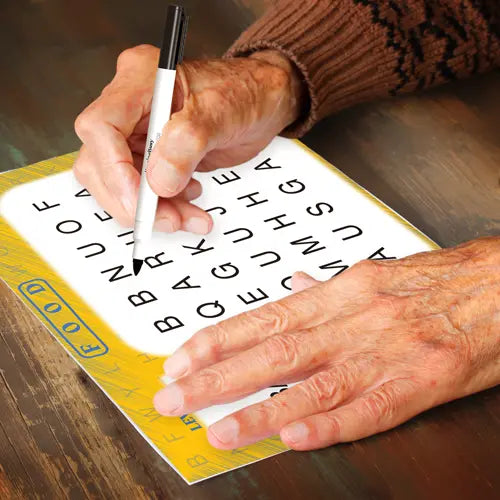
Dementia is a progressive disease that affects the brain, causing a decline in cognitive function, memory loss, and behavioral changes. It can be frustrating and disheartening for both the individual with dementia and their loved ones. However, there are therapeutic tools available that can help ease the symptoms of dementia and improve the quality of life for those affected. One such tool is coloring books for adults.
Coloring Books for Adults with Dementia
Coloring books for adults have become increasingly popular in recent years, and for good reason. Coloring has been shown to have therapeutic benefits, including reducing stress, anxiety, and depression. It can also improve focus and concentration, which can be particularly helpful for those with dementia who experience cognitive decline.
For individuals with dementia, coloring can be a calming and soothing activity that provides a sense of accomplishment and purpose. It can also serve as a way to connect with others and stimulate conversation.
Benefits of Coloring Books for Adults with Dementia
1. Promotes Relaxation and Reduces Anxiety
Coloring can help reduce stress and anxiety levels in individuals with dementia by providing a sense of calm and relaxation. This can lead to improved mood, better sleep quality, and an overall sense of well-being.
2. Stimulates Memory and Encourages Reminiscing
Coloring can stimulate memories and encourage reminiscing, which can be particularly beneficial for individuals with dementia who may struggle with memory recall. This can help improve cognitive function and increase mental stimulation.
3. Provides a Sense of Accomplishment and Boosts Self-Esteem
Completing a coloring page can provide a sense of accomplishment and boost self-esteem, which can be important for individuals with dementia who may struggle with their sense of identity. This can also improve their confidence and independence.
4. Encourages Socialization and Improves Communication Skills
Coloring can be a group activity, which can encourage socialization and improve communication skills in individuals with dementia. This can help them strengthen their relationships with others and feel more connected to their community.
5. Improves Fine Motor Skills and Maintains Dexterity
Coloring requires the use of fine motor skills, which can help maintain dexterity and hand-eye coordination in individuals with dementia. This can also slow down the progression of physical symptoms associated with dementia, such as tremors or loss of motor control.
How to Choose a Coloring Book for Individuals with Dementia
When choosing a coloring book for individuals with dementia, it's important to keep these factors in mind:
1. Consider their interests and abilities
It's important to choose a coloring book that aligns with the individual's interests and abilities. Consider what types of designs or themes they may enjoy, and look for books with large, simple designs that won't be overwhelming or frustrating.
2. Look for familiar objects or scenes
Coloring books with familiar objects or scenes can stimulate memory recall and encourage conversation. Consider books with designs featuring nature, animals, or everyday objects.
3. Consider the medium used for coloring
Some individuals with dementia may have a preference for a certain type of coloring medium. Experiment with different options such as colored pencils, markers, or crayons to find what works best for the individual.
4. Choose books with appropriate difficulty levels
Make sure the coloring book you choose is at an appropriate difficulty level for the individual. Overly complex designs or patterns may be too challenging and lead to frustration.
5. Ensure the coloring book is age-appropriate
Make sure the coloring book is age-appropriate and doesn't contain any content that might be confusing or inappropriate for the individual.
6. Consider using specialized dementia coloring books
There are some coloring books on the market that are specifically designed for individuals with dementia. These books may include prompts or activities that are tailored to the needs of individuals with cognitive impairment.
Different Types of Coloring Books Available for Adults with Dementia
When it comes to coloring books for individuals with dementia, there are several types available. Some may be more suited to the individual's interests or abilities than others. Here are a few different types of coloring books to consider:
1. Traditional Coloring Books
Traditional coloring books are those that feature intricate designs and patterns, such as mandalas or floral arrangements. While these can be challenging, they can also provide a sense of accomplishment when completed.
2. Simple Designs Coloring Books
Simple designs coloring books feature large, easy-to-color designs that are less complex than traditional coloring books. These can be a good option for individuals who find intricate designs overwhelming or frustrating.
3. Themed Coloring Books
Themed coloring books are those that focus on a specific theme or subject matter, such as animals, nature scenes, or famous works of art. These can be a good option for individuals who have a particular interest in a certain topic.
4. Dementia-Specific Coloring Books
Dementia-specific coloring books are those that have been specifically designed for individuals with cognitive impairment. These may include prompts or activities tailored to their needs and abilities.
When choosing the right coloring book for an individual with dementia, it's important to consider their interests and abilities, as well as any physical limitations they may have. It may also be helpful to experiment with different types of coloring books to see what works best for the individual.
Overall, coloring can be a therapeutic tool for individuals with dementia that provides many benefits, including reducing stress and anxiety, improving memory recall and cognitive function, boosting self-esteem and socialization skills, and maintaining dexterity and hand-eye coordination.
Coloring as a Tool for Communication and Connection
Communication and socialization can be challenging for individuals with dementia, as they may struggle to find the right words or express themselves clearly. Coloring can serve as a tool for communication and connection, allowing individuals with dementia to express themselves in a non-verbal way.
When coloring with others, individuals with dementia have the opportunity to connect with their loved ones or caregivers in a meaningful way. They can share their artwork, discuss their color choices, and reminisce about memories associated with the designs they are coloring.
Coloring can also provide a sense of comfort and security during what can be an overwhelming and confusing time. For individuals with dementia who may feel isolated or disconnected from the world around them, coloring provides a way to connect with others and feel part of a community.
In group settings, coloring can serve as an icebreaker activity that encourages socialization and helps participants get to know one another. It can also help break down barriers between individuals from different backgrounds or cultures who may struggle to communicate verbally.
Overall, coloring is a powerful tool for communication and connection that can help improve the quality of life for individuals with dementia. By providing an outlet for self-expression and creating opportunities for socialization, it has the potential to make a real difference in the lives of those affected by this disease.
Ideas for Incorporating Coloring into Daily Routines for Individuals with Dementia
Incorporating coloring into daily routines can be a great way to provide structure and purpose for individuals with dementia. Here are some ideas to consider:
1. Make it part of a morning routine
Coloring can be a calming way to start the day. Consider setting aside time in the morning for coloring as part of a daily routine. This can help establish structure and provide a sense of purpose for the individual.
2. Use it as an activity before bedtime
Coloring can also be a relaxing activity before bedtime, helping individuals wind down and prepare for sleep. This can be particularly helpful for those who struggle with insomnia or other sleep-related issues.
3. Combine it with music therapy
Music therapy has been shown to have therapeutic benefits for individuals with dementia, including reducing anxiety and improving mood. Consider combining coloring with music therapy by playing calming music during coloring sessions.
4. Create a designated coloring area
Creating a designated area for coloring can help establish routine and provide structure for individuals with dementia. This area should be quiet, well-lit, and comfortable, with all necessary supplies within reach.
5. Encourage group coloring sessions
Group coloring sessions can be a great way to encourage socialization and improve communication skills in individuals with dementia. Consider organizing group sessions at the same time each week to establish routine and provide structure.
By incorporating coloring into daily routines, individuals with dementia can experience the therapeutic benefits of this activity on a regular basis, improving their overall quality of life.
Adapting Coloring Activities for Individuals with Physical Limitations or Impaired Vision
For individuals with physical limitations or impaired vision, coloring activities may need to be adapted in order to make them accessible and enjoyable. Here are some creative ways to adapt coloring activities:
1. Use Adaptive Tools and Equipment
There are many adaptive tools and equipment available that can make coloring easier for individuals with physical limitations or impaired vision. For example, there are special grips that can be added to pencils or markers, large-handled scissors for cutting out designs, and magnifying glasses for those with impaired vision.
2. Adjust the Lighting
Proper lighting is essential for individuals with impaired vision. Consider using bright lights or natural light sources to enhance visibility. Avoid glare by positioning the light source behind the individual rather than in front of them.
3. Choose High Contrast Designs
High contrast designs can be helpful for individuals with impaired vision as they provide more visual stimulation. Look for designs with dark outlines and high contrast colors such as black and white or bold primary colors.
4. Incorporate Touch and Texture
For individuals with limited dexterity, incorporating touch and texture into coloring activities can add an additional sensory element that makes the activity more engaging. Consider using textured papers, fabrics, or stickers in addition to traditional coloring materials.
5. Create Collaborative Artwork
Collaborative artwork is a great way to involve individuals with physical limitations in group activities. Instead of each person completing their own design, create larger designs that require multiple people to work together on different sections.
By adapting coloring activities in creative ways, individuals with physical limitations or impaired vision can still enjoy the therapeutic benefits of this activity while also feeling included in group settings.
The Potential for Art Therapy to Slow Down Cognitive Decline in Individuals with Dementia
While coloring can provide many therapeutic benefits for individuals with dementia, it's important to note that it is just one aspect of art therapy. Art therapy as a whole has the potential to slow down cognitive decline and improve quality of life in individuals with dementia.
Studies have shown that art therapy can help reduce agitation and improve communication skills in individuals with dementia. It can also provide a sense of purpose and accomplishment, boosting self-esteem and improving overall mood.
Furthermore, art therapy has the potential to slow down the progression of cognitive decline by stimulating neural pathways in the brain. Engaging in creative activities like coloring or painting can help keep the brain active, potentially reducing the risk of further cognitive decline.
Art therapy can also provide an opportunity for individuals with dementia to express themselves in a non-verbal way, which can be particularly beneficial for those who struggle with communication or have difficulty finding the right words.
Overall, while coloring is just one component of art therapy, it has the potential to improve cognitive function and slow down the progression of cognitive decline in individuals with dementia. By incorporating art therapy into daily routines, individuals with dementia may experience improved quality of life and increased mental stimulation.
Summary
Coloring can be a therapeutic tool for individuals with dementia that provides many benefits, including reducing stress and anxiety, improving memory recall and cognitive function, boosting self-esteem and socialization skills, and maintaining dexterity and hand-eye coordination. When choosing a coloring book for an individual with dementia, it's important to consider their interests and abilities, as well as any physical limitations they may have.
Different types of coloring books are available for adults with dementia, such as traditional coloring books or simple designs coloring books. Coloring also serves as a tool for communication and connection among individuals with dementia. It can be incorporated into daily routines through designated areas or group sessions to establish routine and provide structure.
Additionally, coloring activities can be adapted to make them accessible for individuals with physical limitations or impaired vision. Art therapy as a whole has the potential to slow down cognitive decline in individuals with dementia by stimulating neural pathways in the brain.
Incorporating art therapy into daily routines can improve the quality of life for individuals with dementia by providing mental stimulation, reducing agitation, improving communication skills, and increasing socialization opportunities.
Sources
-
Alzheimer's Association. (2021). Activities for Alzheimer's and Dementia Patients. https://www.alz.org/help-support/caregiving/daily-care/activities
-
American Art Therapy Association. (2021). Art Therapy and Dementia. https://arttherapy.org/art-therapy-and-dementia/
-
Kaimal, G., Ray, K., & Muniz, J. (2016). Reduction of Cortisol Levels and Participants' Responses Following Art Making. Art Therapy, 33(2), 74-80. https://doi.org/10.1080/07421656.2016.1166832
Improve Mood and Reduce Agitation with Keeping Busy's Coloring Books
Coloring books are a great way to reduce agitation and improve mood in seniors with dementia. Keeping Busy's coloring books are specifically designed for seniors and can provide a calming and enjoyable activity.





My Grandma, has dementia and I am helping her with it . I color every day to help my stress levels and my anxiety.